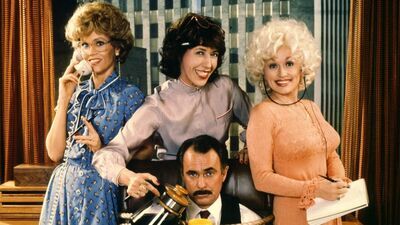
I was so glad that you included the superb costume designs in the film. How did Ann Roth’s wardrobe help to define the characters, both in their “real” and “fantasy” personas?
GL: Absolutely! Two-time Oscar winner Ann Roth knew the women needed to appear smart, not glamorous, in this film. She did this in so many subtle ways in the film. I mean “We’re gonna need a separate locker for the hat.” Brilliant!
CH: There was a lot of consideration taken by Ann to explore the greater context of each character and how each character represented archetypes of woman in society—the working woman, the recent divorcee who has never worked, and the perceived office vixen. We also juxtaposed that with their inner character, which was displayed in each fantasy sequence. Ann also used a lot of red, white, and blue in her costumes to show these were working women who were valued in America.
Do you believe that the film changed the perception or the conversation around workplace issues? Around feminism?
GL: In some ways yes. In our film, Karen Nussbaum shared that things did change as far as women stepping into leadership roles, and other smaller steps of improvement by the end of the eighties. But as we all know, not enough has changed.
CH: I think many women and organizations used the film as an example of what happens when there is solidarity of women in the workplace. When women come together, greater change can happen. The film also allowed the 9 to 5, National Association of Working Women organization of working women to flourish. They were able to use the film in their grassroots campaign and tours to create new chapters all around the US, discussing the issues in the film such as: equal pay, job advancement, sexual harassment, and maternity leave.
We talk today a lot about “representation” mattering. We had serious and comic portrayals of office life in other movies, but was this focus on female office workers a first?
GL: Dolly, Lily, and Jane were first on so many levels. Until this film, studios did not believe women could carry a picture to success at the box office without a male star. Women office workers (well over 20 million) in 1980 when the film was released, went in droves to the theaters. They knew finally their struggles were being heard and shared in a major way.

